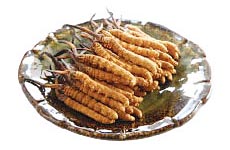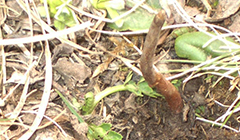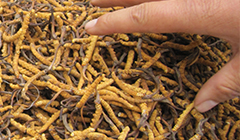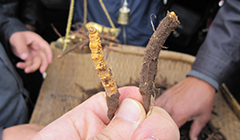Knowledge
Chinese Cordyceps
What is Wild Cordyceps?
Overview
 As a combined body of insect and fungus, Chinese Wild Cordyceps (Caterpillar fungi) are the result of a parasitic relationship between the fungus Wild Cordyceps and the larva of the ghost moth. Caterpillar fungi belongs to Clavicipitaceae under Hypocreales; in summer and autumn, its spores develop into mycelium and attack the larva of the ghost moth to grow and proliferate in their bodies and absorb nutrient from the larva body. The larva end up as a shell of mycelium and form sclerotia. The larva usually hibernates in the soil during winter. In the following summer, the fungus which has invaded the larva bodies will extrude as columnar fruiting bodies and emerges from the ground. Since its shape resembles grass, it is named as dong chong xia cao (冬蟲夏草) meaning "winter worm, summer grass".
As a combined body of insect and fungus, Chinese Wild Cordyceps (Caterpillar fungi) are the result of a parasitic relationship between the fungus Wild Cordyceps and the larva of the ghost moth. Caterpillar fungi belongs to Clavicipitaceae under Hypocreales; in summer and autumn, its spores develop into mycelium and attack the larva of the ghost moth to grow and proliferate in their bodies and absorb nutrient from the larva body. The larva end up as a shell of mycelium and form sclerotia. The larva usually hibernates in the soil during winter. In the following summer, the fungus which has invaded the larva bodies will extrude as columnar fruiting bodies and emerges from the ground. Since its shape resembles grass, it is named as dong chong xia cao (冬蟲夏草) meaning "winter worm, summer grass". Origin
Chinese Wild Cordyceps live on the intersecting lands in Northwest China (Tibet, Qinghai, Sichuan & Yunnan Province). Among them, the best Wild Cordyceps are produced in Tibet and Qinghai due to high altitude and naturally cold environment. Sichuan and Yunnan province follow, but due to climatic and geographic factors, the Wild Cordyceps produced are thinner and sold in bundles.Appearance
 It can be divided into "worm"(larva) section and "grass"(sporophore) section.
It can be divided into "worm"(larva) section and "grass"(sporophore) section.- The "worm" part appears dark yellowish or yellowish brown with 20 to 30 pairs of segments with several annular marks and eight pairs of feet present at the abdomen with the middle four pairs more prominent. The cross-section has a prominent U-shaped dark brown mark and the organism is brittle.
- The sporophore is the base and protrudes from the head of the larva. Slender with longitudinal striate, and its top is elliptical, enlarged, with dark brown or blackish brown surface and with numerous protruding granular peritheciums. Soft and tough in texture.
- Good larva should be plump, yellowish, dried and complete in shape, while the sporophore should be as short as possible.
Function
Wild Cordyceps are mild and sweet in nature, belonging to the lungs and kidneys Meridan. It is an excellent tonic which helps invigorate lung and kidney functions, supplements essence, improves inspiration to relieve dyspnea, eliminates phlegm, and stops bleeding. It improves body immunity when taken over a prolonged period.Characteristic
Sweet in taste, mildly warm in nature.
Other information
Wild Cordyceps grow in highlands of altitude more than 3000m. The higher the altitude, the colder the weather and thus the stronger the larva bodies. The shape, color, tail length and segment of the larva body differ according to climate.
Way of storage
Wild Cordyceps should be stored in a cool and dry place. They should be placed in a refrigerator (at 0-8˚C) after opening. If they are to be consumed over a long period of time, it is better to seal properly and place in a freezer (at -18˚C or below).Standard
- All Chinese Wild Cordyceps are imported directly from the place of origin, Qinghai-Tibet Plateau and selected by hand to ensure no impurities or inferior Wild Cordyceps are mixed. [Best from the origin].
- The Wild Cordyceps are graded according to the thickness of the larva body. The thicker, the stronger the effect and the higher is the price. We have established a [pieces system] available for any-time purchase of goods of the same grade.
- Using metal detector of advanced Japan technology and X-ray inspection machine, all our Wild Cordyceps meet safety standards to ensure [no metal] is included.
- Each lot of Wild Cordyceps we purchase are tested for their color and taste through random sampling to guarantee [natural color and aroma] and thus prevent quality problems.
- Currently it is impossible to pick bamboo sticks through machine and it entirely depends on human-hand picking. Thus, it is possible that minute amount of bamboo sticks are left. However, we ensure that [over 99.90% of our Wild Cordyceps do not contain bamboo sticks].
How to identify Wild Cordyceps?
Genuinity
 Due to strict geographical criteria and parasitism, there is always a shortage in Wild Cordyceps supply, boosting its prices. In recent years, increasing number of people recognizes the functions of Wild Cordyceps and the demand continues to grow. Since supply is scarce while demand is huge, inferior or fake Wild Cordyceps are overflowing on the market. Consumers need to be aware of such misbehaviors:
Due to strict geographical criteria and parasitism, there is always a shortage in Wild Cordyceps supply, boosting its prices. In recent years, increasing number of people recognizes the functions of Wild Cordyceps and the demand continues to grow. Since supply is scarce while demand is huge, inferior or fake Wild Cordyceps are overflowing on the market. Consumers need to be aware of such misbehaviors:1. Add toothpicks to broken segments and pretend as complete body to ask for higher prices
2. Add iron wire or soak the larva segment into mud water to increase weight
3. Produce fake Wild Cordyceps by cornstarch
Hints
Customers are suggested to look for Wild Cordyceps from shops of goodwill and larger scale, and shops that sell Wild Cordyceps as individual items.Which type of Wild Cordyceps fits me?

Wild Cordyceps are graded according to the thickness of the larva part. The colder is the climate, the thicker are the larva. Tibetan Plateau is located at high altitudes and extremely cold climate, producing thicker Wild Cordyceps referred to as the top grade Tibetian Wild Cordyceps, precious Wild Cordyceps and selected Wild Cordyceps (the thicker, the higher the price).
For Wild Cordyceps from Yunnan Province and Sichuan Province, due to climatic and geographical reasons, the Wild Cordyceps produced are slimmer, thus sold as bunches.
Also, in the process of digging and transporting, Wild Cordyceps would break into pieces and thus thick segments or segments are sold at lower prices. They still have the same nutritional value.
Cooking
Chinese Wild Cordyceps (2 qian), American Ginseng (5 qian), Dried Red Dates (5 pieces), Pelodiscus sinensis (1), Lean pork (12 taels), Make soup with the above ingredients to nourish the lungs and the kidneys, replenish the Yin and the vital energy.Preparing
-
 Soak the Wild Cordyceps in water for 5 minutes, brush to remove impurities and ready for cooking.
Soak the Wild Cordyceps in water for 5 minutes, brush to remove impurities and ready for cooking. - The Wild Cordyceps can also be crushed into powder form and made into tea by adding water or add to soup and stew.
